
Mushrooms Demystified: A Comprehensive Guide to the Fleshy Fungi is a mushroom field and identification guide by American mycologist David Arora, published in 1979 and republished in 1986. [1]

Mushrooms Demystified: A Comprehensive Guide to the Fleshy Fungi is a mushroom field and identification guide by American mycologist David Arora, published in 1979 and republished in 1986. [1]

In mycology, a partial veil is a temporary structure of tissue found on the fruiting bodies of some basidiomycete fungi, typically agarics. Its role is to isolate and protect the developing spore-producing surface, represented by gills or tubes, found on the lower surface of the cap. A partial veil, in contrast to a universal veil, extends from the stem surface to the cap edge. The partial veil later disintegrates, once the fruiting body has matured and the spores are ready for dispersal. It might then give rise to a stem ring, or fragments attached to the stem or cap edge. In some mushrooms, both a partial veil and a universal veil may be present.

Russula claroflava, commonly known as the yellow swamp russula or yellow swamp brittlegill, is a basidiomycete mushroom of the genus Russula. It is found in wet places under birch and aspen woodlands across Europe and North America. It has a yellow cap, white gills and stipe and bruises grey. It is mild-tasting and regarded as good to eat.
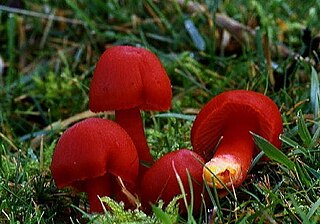
Hygrocybe coccinea, sometimes called the scarlet hood, scarlet waxcap or righteous red waxy cap, is a colourful member of the mushroom genusHygrocybe. These waxcaps are found across the Northern Hemisphere from China and Japan to Europe and North America. The small bright red mushroom is a familiar sight in unimproved grasslands in Europe in late summer and autumn, and woodlands in North America in winter.

Russula sanguinaria, commonly known as the bloody brittlegill, is a strikingly coloured mushroom of the genus Russula, which has the common name of brittlegills. It is bright blood-red, inedible, and grows in association with coniferous trees. It was previously widely known as Russula sanguinea.

Lactarius rufus is a common, medium-sized member of the mushroom genus Lactarius, whose many members are commonly known as milkcaps. Known by the common name of the rufous milkcap, or the red hot milk cap in North America. It is dark brick red in color, and grows with pine or birch trees.
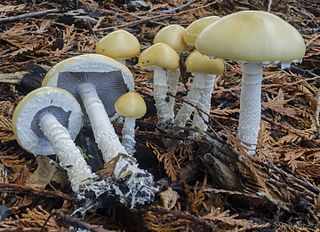
Stropharia ambigua, sometimes known as the questionable Stropharia, is a saprotrophic agaric mushroom, commonly fruiting in leaf litter and wood chips in the Pacific Northwest.
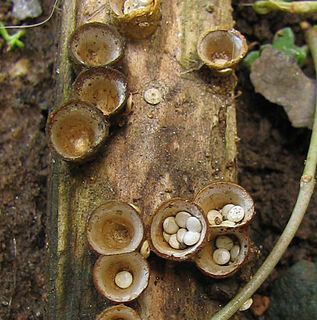
The peridium is the protective layer that encloses a mass of spores in fungi. This outer covering is a distinctive feature of gasteroid fungi.

Scutiger is a genus of fungi in the family Albatrellaceae, which includes S. oregonensis, the fungus tuber.

Agaricus semotus is a woodland mushroom of the fungus order Agaricales. It, like many of its relatives, can be found spread throughout wooded, moist areas in the southern United States, and has been found in areas ranging from California to Florida; it is also indigenous to Great Britain and Europe. A. semotus has also been collected in New Zealand. Although various authors disagree about its edibility, its modest size prevents it from being a significant source of nutrition.

Hygrophorus subalpinus, commonly known as the subalpine waxycap, is a species of white snowbank fungus in the family Hygrophoraceae. Found in the mountains of western North America, it is found growing on the ground under conifers, usually near snowbanks.

Russula albidula is a species of mushroom in the genus Russula. The species, known in the vernacular as the boring white russula or the whitish brittlegill, is nondescript, with a small or medium dirty white fruit body, and a highly acrid taste. It is found in eastern North America.

Hypomyces chrysospermus, the bolete eater, is a parasitic ascomycete fungus that grows on bolete mushrooms, turning the afflicted host a whitish, golden yellow, or tan color. It is found in Eurasia and North America, as well as southwest Western Australia. Unlike the related Lobster mushroom, H. lactifluorum, the bolete eater and its afflicted host mushrooms are inedible.

All That the Rain Promises, and More... is a wild mushroom identification and field guide by American mycologist David Arora and published in 1991 by Ten Speed Press in Berkeley, California. The book includes detailed descriptions of more than 200 edible and poisonous mushroom species, as well as recipes, stories, and information on uses of various species such as for dying hair and clothing or playing games. In the preface, Arora writes, "In leafing through these pages, you may wonder what all the 'fanciful,' 'foolish,' or (shudder) 'extraneous' material is doing in a factual guide. After all, it is the practical, hands-on, how-to-identify information that makes this book useful and gives it substance. But I ask: is it any stranger or less desirable to sprinkle the facts with flakes of fancy than it is to liven up solemn, substantial fare like potatoes with something fancier and more flavorful, like wild mushrooms?"
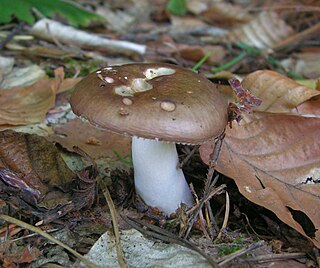
Russula integra, commonly known as the entire russula, is a species of mushroom. The fungus stems from the huge genus of Russula. It is found in conifer forests across Europe and throughout North America. The fruiting body is mildly flavoured with a slight cashew-like taste and dense flesh. It is edible and most commonly consumed in Central Europe.
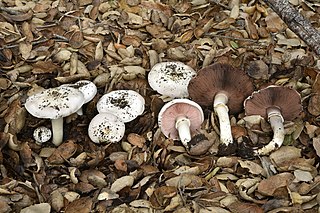
Agaricus californicus, commonly known as the California agaricus, is a poisonous mushroom in the section Xanthodermati of the genus Agaricus.

Agaricus cupreobrunneus, commonly known as the brown field mushroom, is an edible mushroom of the genus Agaricus.

Ramaria rasilispora, commonly known as the yellow coral, is a coral mushroom in the family Gomphaceae. Described as new to science in 1974, it is found in western North America south to Mexico, and in the eastern Himalaya.

Helvella vespertina is a species of fungus in the family Helvellaceae. It is found in Western North America under conifers. Some specimens have a white moldy appearance, having been colonised by the parasitic Ascomycete fungus Hypomyces cervinigenus.

Phlebia radiata, commonly known as the wrinkled crust, is a common species of crust fungus in the family Meruliaceae. It is widespread in the Northern Hemisphere. It grows as a wrinkled, orange to pinkish waxy crust on the decaying wood of coniferous and deciduous trees, in which it causes a white rot. The fungus was first described scientifically in 1821 by Elias Magnus Fries.
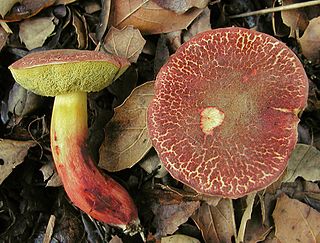
Xerocomellus dryophilus, commonly known as the oak-loving bolete and formerly known as Boletus dryophilus or Xerocomus dryophilus, is a basidiomycete fungus in the family Boletaceae native to North America. It appears to only occur under the coast live oak, and is only found in California, where it is one of the most common boletes in the Los Angeles and San Diego counties.